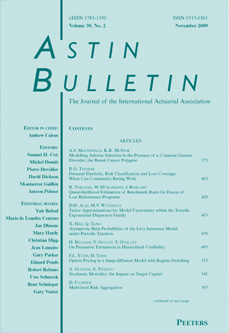 previous article in this issue previous article in this issue | next article in this issue  |

|
Document Details : Title: Dividend Moments in the Dual Risk Model Subtitle: Exact and Approximate Approaches Author(s): CHEUNG, Eric C.K. , DREKIC, Steve Journal: ASTIN Bulletin Volume: 38 Issue: 2 Date: November 2008 Pages: 399-422 DOI: 10.2143/AST.38.2.2033347 Abstract : In the classical compound Poisson risk model, it is assumed that a company (typically an insurance company) receives premium at a constant rate and pays incurred claims until ruin occurs. In contrast, for certain companies (typically those focusing on invention), it might be more appropriate to assume expenses are paid at a fixed rate and occasional random income is earned. In such cases, the surplus process of the company can be modelled as a dual of the classical compound Poisson model, as described in Avanzi et al. (2007). Assuming further that a barrier strategy is applied to such a model (i.e., any overshoot beyond a fixed level caused by an upward jump is paid out as a dividend until ruin occurs), we are able to derive integro-differential equations for the moments of the total discounted dividends as well as the Laplace transform of the time of ruin. These integro-differential equations can be solved explicitly assuming the jump size distribution has a rational Laplace transform. We also propose a discrete-time analogue of the continuous-time dual model and show that the corresponding quantities can be solved for explicitly leaving the discrete jump size distribution arbitrary. While the discrete-time model can be considered as a stand-alone model, it can also serve as an approximation to the continuous-time model. Finally, we consider a generalization of the so-called Dickson-Waters modification in optimal dividends problems by maximizing the difference between the expected value of discounted dividends and the present value of a fixed penalty applied at the time of ruin. |
